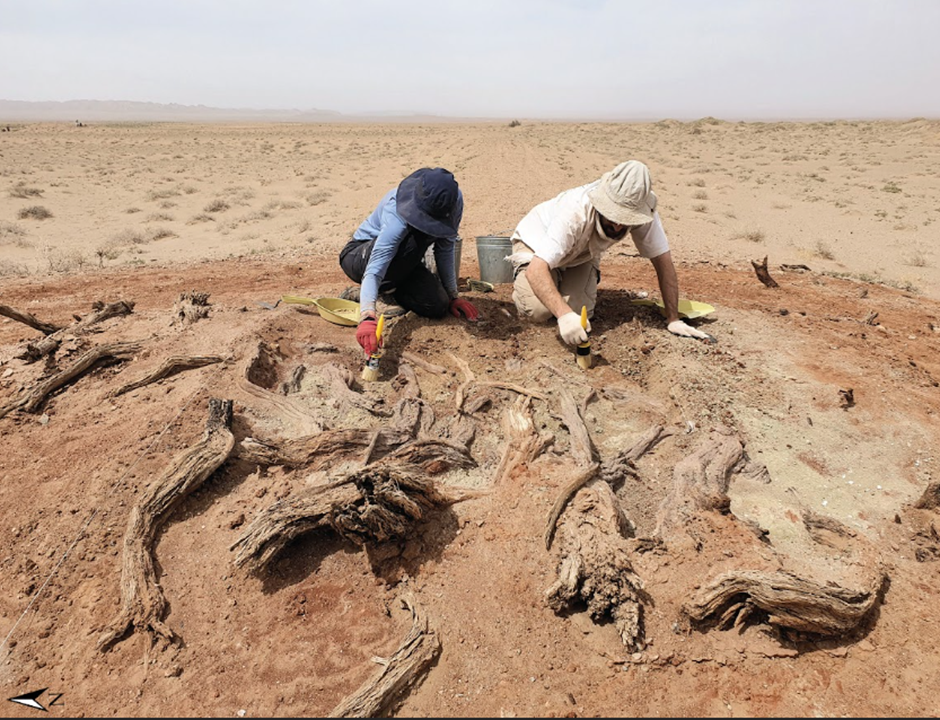
June 1, 2025 – A new study, led by Professor Gideon Shelach-Lavi and Mr. Dan Golan, archaeologists from the Department of Asia Studies at the Hebrew University of Jerusalem and conducted in Mongolia in cooperation with Prof. Chunag Amartuvshin from the National University of Mongolia and Prof. William Honeychurch from Yale University, sheds new light on one of the least understood segments of medieval Inner Asian infrastructure: the Gobi Wall.
Stretching 321 kilometers across the highland deserts of Mongolia, the Gobi Wall is part of an extensive wall system that once spanned from China into Mongolia. Until now, its origins, function, and historical context remained largely unknown. Through an ambitious international expedition combining remote sensing, pedestrian surveys, and targeted excavations, Professor Shelach-Lavi and his team have uncovered compelling new evidence about the wall’s construction and purpose.
The study reveals that the wall and its garrison complexes were primarily constructed during the Xi Xia (1038–1227 CE), a dynasty ruled by the Tungut tribe of Western China and Southern Mongolia. This period was marked by the expansion of frontier defense systems amid significant geopolitical transformations. Contrary to the traditional view of such walls as solely defensive structures, the research highlights the Gobi Wall’s multifunctional role in boundary demarcation, resource management, and the consolidation of imperial control.
While the main phase of construction and occupation belongs to the Xi Xia, the expedition revealed evidence of periodic occupation of this remote area from the 2nd century BCE through the 19th century CE, with layers of artifacts pointing to the wall’s long-term strategic significance. The fortifications were made of rammed earth, supported by stone and wood reinforcements, illustrating the adaptive use of local materials in this arid, remote environment.
Moreover, the study’s ecological and spatial analysis shows that the wall’s route was carefully selected based on resource availability, particularly water and wood. The placement of forts and garrisons took advantage of natural geographic features such as mountain passes and sand dunes to enhance the wall’s effectiveness.
“This research challenges long-standing assumptions about imperial frontier systems in Inner Asia,” said Prof. Shelach-Lavi. “The Gobi Wall was not just a barrier—it was a dynamic mechanism for governing movement, trade, and territorial control in a challenging environment.”
The findings offer critical insights into the interplay between environmental adaptation and state power in medieval empires, with broader implications for understanding ancient infrastructure and its legacy on today’s political and ecological landscapes.
The research paper titled “Exploring the Gobi Wall: Archaeology of a Large-Scale Medieval Frontier System in the Mongolian Desert” is now available in Land and can be accessed here.
Researchers:
Dan Golan1, Gideon Shelach-Lavi1, Chunag Amartuvshin2, Zhidong Zhang1, Ido Wachtel1, Jingchao Chen1, Gantumur Angaragdulguun1, Itay Lubel1, Dor Heimberg1, Mark Cavanagh3, Micka Ullman4 , William Honeychurch5
Institutions:
1. Department of Asian Studies, Hebrew University of Jerusalem
2. Department of Anthropology and Archaeology, National University of Mongolia
3. Institute of Archaeology, Tel-Aviv University
4. Institute of Archaeology, Haifa University
5. Department of Anthropology, Yale University
Funding:
This research was funded by the European Research Council under the European Union’s Horizon 2020 research and innovation program (“The Wall” project, grant agreement No. 882894).




